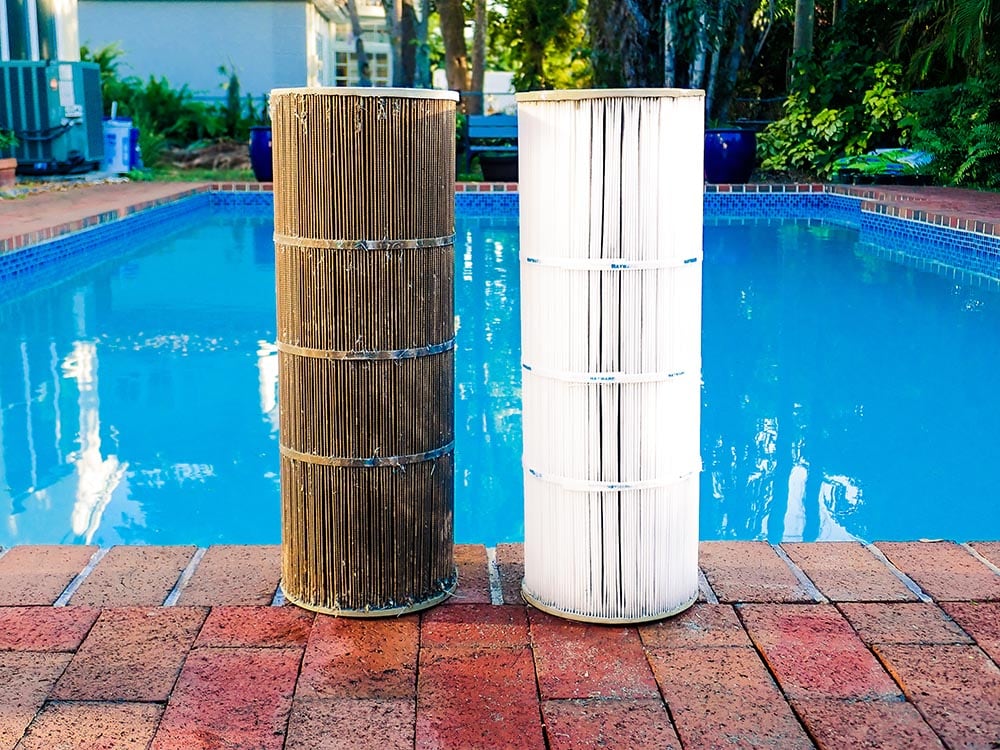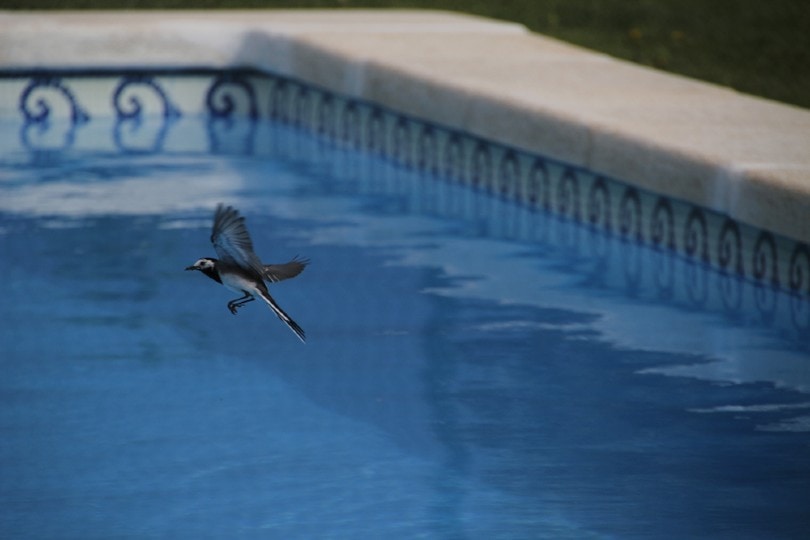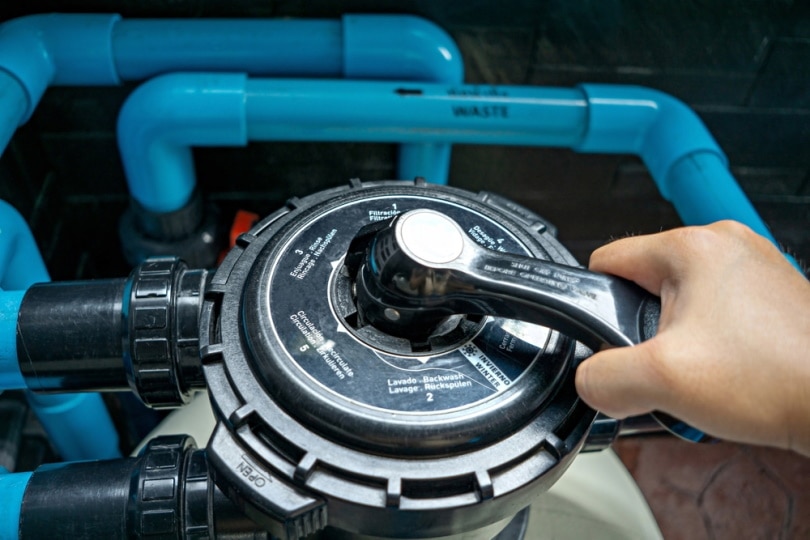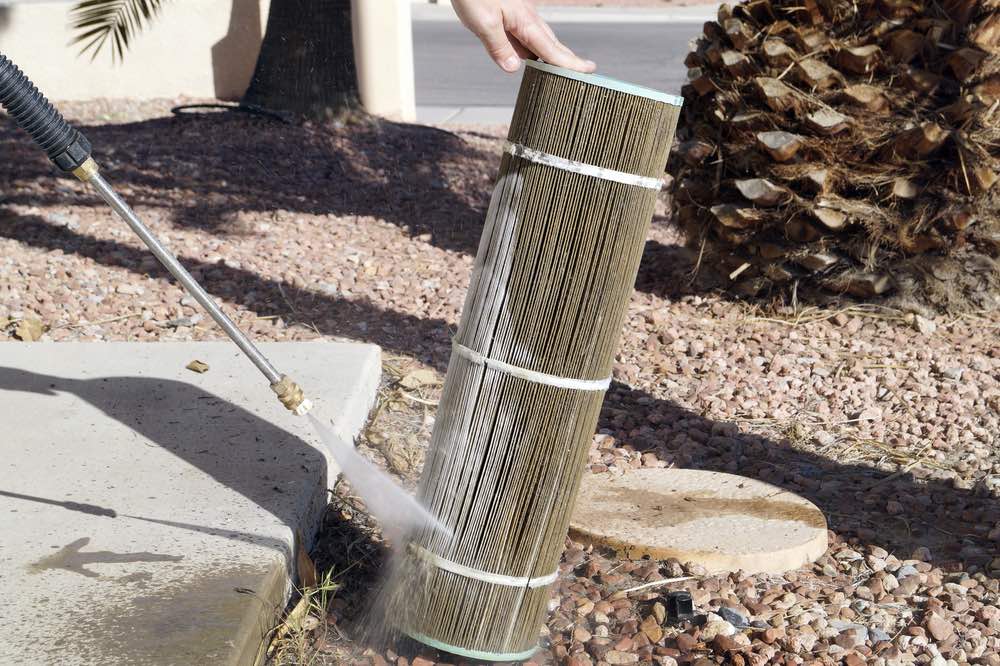How Often Should You Clean a Pool Filter? Signs & Types
-
Pete Ortiz
- Last updated:

If you’re thinking of owning a swimming pool, you are probably aware of what it entails. After all, having a pool set up at home is not cheap. Besides the initial cost, you must ensure you invest in proper pool maintenance tools and equipment.
One crucial tool is a pool filter. Pool filters are the heart of any pool system, without which you may never enjoy your pool. They clean the water and keep it safe to swim in. Consequently, the pool filter has to be cleaned for it to work optimally. Failure to do so will result in poor water quality and health problems for swimmers.
But how often should you clean your pool filter? In this article, we’ll discuss the frequency of cleaning. We have broken this down into the different types of pool filters. But first, what tells you your pool filter needs cleaning?
Signs Your Pool Filter Needs Cleaning
If you notice your pool filter is not performing as well as it used to, you may need to clean it. Here are some signs to be on the lookout for!

Water Pressure
The water pressure in your pool should not be higher than ten psi.
If the water pressure remains constant, your pool filter is working well. However you may notice your water pressure is higher than the norm after reading it, so there may be dirt accumulated on the filter.
Change in water pressure can be because there’s a lot of debris in the filter, such that it’s unable to push water through well. So it works harder than usual. If this happens often, the filter needs cleaning.
Water Flow
One of the easiest ways to determine if your pool filter needs cleaning is to look at how much water is flowing through it. If you notice the water flow is decreasing, this could be an indication that there’s something wrong with your pool filter.
A clogged or dirty filter will cause reduced water flow through it. Also, it reduces its ability to circulate water throughout your pool. If untreated, this could lead to other problems such as algae growth or clogging from dirt particles and debris.
Water Clarity
Some particles that get into the water can clog up the filter and reduce its ability to remove contaminants from the pool water. It leads to a less clear swimming area for everyone! When you notice that your pool water is unclear, it may be time to clean your filter to improve the clarity of your water.
How Often Should You Clean a Pool Filter?
You should clean a pool filter often to keep the water in your pool clean and clear. However, the cleaning frequency depends on the type of pool filter, the size of the pool, and the amount of debris in it.
The larger the pool, the more often you should clean it. Here, we’ll look at how often you should clean a pool filter, depending on the filter type.
1. Cartridge Pool Filters

Cartridge pool filters use cartridges to remove dirt and debris from pool water. Cartridges are made of several layers of material that trap dirt and debris as the water passes through them. These pool filters operate at a lower pressure compared to sand and diatomaceous earth pool filters.
Cartridge pool filters are popular because they are easy to use and maintain. They also don’t clog easily and can last for years. They need cleaning every two to six weeks.
2. Diatomaceous Earth Pool Filters
This is a type of filter that uses diatomaceous earth to filter out dirt and debris from pool water. Diatomaceous earth (also known as D. E.) is an abrasive substance made up of fossilized remains of algae and other organisms.
People use the powder form of D. E. to make all kinds of products including toothpaste (to help remove plaque), filters for swimming pools, and other types of water filtration systems.
A diatomaceous earth pool filter will need cleaning after using it for one to two months.
3. Sand Pool Filters

This pool filter uses sand as its filtering medium. Sand pool filters are one of the most common types of pool filters. Usually, they are the least expensive of all pool filters and they need minimal maintenance compared to the other types.
However, they are less effective at removing chlorine compared to diatomaceous earth and cartridge pool filters. Clean your sand pool filter every one to four weeks.
How Do You Clean a Pool Filter?
Cleaning your pool filter is one crucial thing you can do to ensure that your pool stays clean, clear, and safe. It’s also the least expensive and most effective method of keeping your pool water clean and clear.
A dirty pool filter will reduce the efficiency of your pump and make it work harder. It can also get damaged over time. Each type of pool filter has different steps you need to follow when cleaning it.
We’ll look at each type and how to clean it in this section.
Cleaning Cartridge Pool Filters
1. Switch Off the Pump and Depressurize the Filter Tank
Before you begin cleaning, turn off your pool pump. It’ll allow you to drain water out of the filter tank. Make sure there is no water in the lines or filter. If there is, you may want to use a pressurized garden hose to drain all the water from your filter system before you clean.
If your pool filter has a timer, ensure you remove anything that may make the timer switch back on.
2. Remove the Cartridge in the Filter Tank
The cartridge is inside the filter tank. Usually, it’s made of plastic or metal. Open up the lid of your pool filter and remove it to access the cartridge. Then, remove it and put it aside. Check if there are any damages or wear and tear to the cartridge. If you find any, fix it.
3. Clean the Pool Filter Cartridge
Use a brush and warm water to clean the pool filter cartridge. If you want to use chemicals, only use those specifically made for cleaning pool filters. You can also use a spray nozzle.
Ensure you clean between the pleats. You can also prepare a solution of one part muriatic acid and 20 parts water. Then, dip your filters in the solution. Do not use bleach or other household cleaners that may damage the vinyl coating on your pool filter cartridge.
4. Replace the Filter Cartridge and Re-Pressurize
If the filter cartridge is not damaged, you can put it back, re-prime the filter, and bring the system back to normal operation. But if the filter cartridge is damaged beyond repair, replace it with a new one.
Once you re-attach the cartridge into position, replace the filter top, close the clamps, and switch on the pool filter.

Diatomaceous Earth (DE) Pool Filters
1. Backwash and Drain the Diatomaceous Earth Filter
Switch off the pump and backwash the DE filter. Run water through it in the reverse direction from normal. It takes about one to two minutes. It will remove any large particles from the diatomaceous earth pool filter and loosen any dirt that has accumulated on the filter’s pleats. After that, drain the filter of all water so that you can clean it easily.
2. Remove DE Filter Manifold
Take off the latching mechanisms holding the pool filter. Follow the instructions manual if you’re unsure of how to do it. Remove the stainless steel screen from inside the manifold, but take care not to damage or bend it. The screen protects your DE from damage if you have to remove it when cleaning.
3. Soak or Rinse Filter Grids or Fingers
Rinsing or soaking filter grids removes any remaining dirt and debris that may be stuck on them. Use a garden hose to spray off the grids or fingers with water. You can also use a pool pump to rinse the grids or fingers at low pressure.
4. Attach the Filter Back
Put the clean diatomaceous earth back into place on top of your pool motor. Ensure it fits snugly against the motor’s housing. Run it through at least two cycles before using it again.
5. Add Fresh Diatomaceous Earth Powder
Adding fresh diatomaceous earth powder will replace what was lost during cleaning. The exact amount will vary depending on how much filtration capacity has been lost during cleaning. You can check the instruction manual to determine how much DE powder to add.

Sand Pool Filters
1. Backwash the Sand Filter
The first step in cleaning your sand filter is to backwash it to remove any dirt and debris that has built up in it.
2. Add a Filter Cleaning Solution
Switch off the pump and change the valve to “filter”. Add a solution to clean the sand filter back into it by following the manufacturer’s instructions.
Then switch on the pump for around 15 minutes. It’ll transfer the cleaning solution from the pump to the filter. After that, switch it off and allow it to rest for about eight hours. This solution will help remove any dirt and grime stuck in your sand bed.
3. Backwash the Filter Again
When you finish cleaning your sand filter, backwash it once again before returning it to service. It should take about three to five minutes to remove dirt and debris. Backwashing once again will ensure that all dirt and debris are removed from your pool water. Then, switch it on.
Conclusion
Keeping your pool filters clean is crucial as it ensures your pool or spa water remains healthy and clean.
Pool filters run continuously and remove contaminants from the water. So, your pool water remains clear, sparkling, and appealing, and you can use your pool whenever you want. But to achieve this, you have to ensure the pool filters are clean.
If you don’t clean your filter often, it can get clogged up with debris, which destroys it or reduces its effectiveness. So, there you have it! You now know how often you should clean a pool filter. Now you won’t let it go for too long without making plans to clean it.
Featured Image Credit: MDIYer, Shutterstock
Contents


